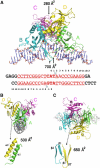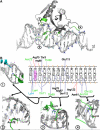The restriction fold turns to the dark side: a bacterial homing endonuclease with a PD-(D/E)-XK motif
- PMID: 17410205
- PMCID: PMC1864971
- DOI: 10.1038/sj.emboj.7601672
The restriction fold turns to the dark side: a bacterial homing endonuclease with a PD-(D/E)-XK motif
Abstract
The homing endonuclease I-Ssp6803I causes the insertion of a group I intron into a bacterial tRNA gene-the only example of an invasive mobile intron within a bacterial genome. Using a computational fold prediction, mutagenic screen and crystal structure determination, we demonstrate that this protein is a tetrameric PD-(D/E)-XK endonuclease - a fold normally used to protect a bacterial genome from invading DNA through the action of restriction endonucleases. I-Ssp6803I uses its tetrameric assembly to promote recognition of a single long target site, whereas restriction endonuclease tetramers facilitate cooperative binding and cleavage of two short sites. The limited use of the PD-(D/E)-XK nucleases by mobile introns stands in contrast to their frequent use of LAGLIDADG and HNH endonucleases - which in turn, are rarely incorporated into restriction/modification systems.
Figures







References
-
- Belfort M, Perlman PS (1995a) Mechanisms of intron mobility. J Biol Chem 270: 30237–30240 - PubMed
MeSH terms
Substances
Associated data
- Actions
LinkOut - more resources
Full Text Sources
Other Literature Sources
Molecular Biology Databases

